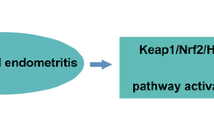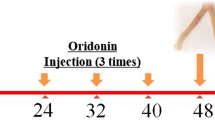Abstract
Uterine cervical carcinoma (UCC) is one of the most common malignant tumors in females, and UCC has a close relationship with chronic cervicitis. As the endogenous “braking signal,” lipoxins can regulate anti-inflammation and the resolution of inflammation. We investigated the effect of lipoxin A4 (LXA4) on the proliferation, apoptosis, and migration in lipopolysaccharide (LPS)-stimulated Hela cells. We demonstrated that LXA4 could significantly suppress p53, cyclin D1 expression, and migration of LPS-stimulated Hela cells via nuclear factor-κB (NF-κB) pathway, and these effects could be blocked by Boc-2, the specific inhibitor of FPR2/ALX (the receptor of LXA4). We presented evidence for a novel role of LXA4 on the proliferation and migration in LPS-stimulated Hela cells, and FPR2/ALX was involved in the procedures. These results showed that LXA4 could be a possible candidate for UCC therapy, and blocking the activation of NF-κB would be an effective drug target.






Similar content being viewed by others
REFERENCES
Finger, E.C., and A.J. Giaccia. 2010. Hypoxia, inflammation, and the tumor microenvironment in metastatic disease. Cancer Metastasis Reviews 29(2): 285–293.
Kuper, H., H.O. Adami, and D. Trichopoulos. 2000. Infections as a major preventable cause of human cancer. Journal of Internal Medicine 248(3): 171–183.
Pisani, P., D.M. Parkin, N. Munoz, et al. 1997. Cancer and infection: estimates of the attributable fraction in 1990. Cancer Epidemiology, Biomarkers & Prevention 6(6): 387–400.
Rahman, M.A., D.K. Dhar, R. Masunaga, et al. 2000. Sulindac and exisulind exhibit a significant antiproliferative effect and induce apoptosis in human hepatocellular carcinoma cell lines. Cancer Research 60(8): 2085–2089.
Morris, T., M. Stables, and D.W. Gilroy. 2006. New perspectives on aspirin and the endogenous control of acute inflammatory resolution. ScientificWorldJournal 6: 1048–1065.
Hao, H., M. Liu, P. Wu, et al. 2011. Lipoxin A4 and its analog suppress hepatocellular carcinoma via remodeling tumor microenvironment. Cancer Letters 309(1): 85–94.
Chen, Y., H. Hao, S. He, et al. 2010. Lipoxin A4 and its analogue suppress the tumor growth of transplanted H22 in mice: the role of antiangiogenesis. Molecular Cancer Therapeutics 9(8): 2164–2174.
Balkwill, F., and L.M. Coussens. 2004. Cancer: an inflammatory link. Nature 431(7007): 405–406.
Li, Y.S., P. Wu, X.Y. Zhou, et al. 2008. Formyl-peptide receptor like 1: a potent mediator of the Ca2+ release-activated Ca2+ current ICRAC. Archives of Biochemistry and Biophysics 478(1): 110–118.
Fierro, I.M., J.L. Kutok, and C.N. Serhan. 2002. Novel lipid mediator regulators of endothelial cell proliferation and migration: aspirin-triggered-15R-lipoxin A(4) and lipoxin A(4). The Journal of Pharmacology and Experimental Therapeutics 300(2): 385–392.
Liu, S., P. Wu, D. Ye, et al. 2009. Effects of lipoxin A(4) on CoCl(2)-induced angiogenesis and its possible mechanisms in human umbilical vein endothelial cells. Pharmacology 84(1): 17–23.
Zhou, X.Y., Y.S. Li, P. Wu, et al. 2009. Lipoxin A(4) inhibited hepatocyte growth factor-induced invasion of human hepatoma cells. Hepatology Research 39(9): 921–930.
Xiong, J., P. Zeng, X. Cheng, et al. 2013. Lipoxin A4 blocks embryo implantation by controlling estrogen receptor alpha activity. Reproduction 145(4): 411–420.
Lin, F., P. Zeng, Z. Xu, et al. 2012. Treatment of Lipoxin A(4) and its analogue on low-dose endotoxin induced preeclampsia in rat and possible mechanisms. Reproductive Toxicology 34(4): 677–685.
Lin, F., X. Yu, X. Zhang, et al. 2013. A synthetic analog of lipoxin A4 partially alleviates dexamethasone-induced fetal growth restriction in rats. Placenta 34(10): 941–948.
Zheng, S., Q. Wang, Q. He, et al. 2011. Novel biphasic role of LipoxinA(4) on expression of cyclooxygenase-2 in lipopolysaccharide-stimulated lung fibroblasts. Mediators of Inflammation 2011: 745340.
Huang, Y.H., H.M. Wang, Z.Y. Cai, et al. 2014. Lipoxin A4 inhibits NF-kappaB activation and cell cycle progression in RAW264.7 cells. Inflammation 37(4): 1084–1090.
Zhou, X.Y., Z.J. Yu, D. Yan, et al. 2013. BML-111, a lipoxin receptor agonist, protected carbon tetrachloride-induced hepatic fibrosis in rats. Inflammation 36(5): 1101–1106.
Simiele, F., A. Recchiuti, D. Mattoscio, et al. 2012. Transcriptional regulation of the human FPR2/ALX gene: evidence of a heritable genetic variant that impairs promoter activity. The FASEB Journal 26(3): 1323–1333.
Naugler, W.E., and M. Karin. 2008. NF-kappaB and cancer-identifying targets and mechanisms. Current Opinion in Genetics & Development 18(1): 19–26.
Pikarsky, E., R.M. Porat, I. Stein, et al. 2004. NF-kappaB functions as a tumour promoter in inflammation-associated cancer. Nature 431(7007): 461–466.
Greten, F.R., L. Eckmann, T.F. Greten, et al. 2004. IKKbeta links inflammation and tumorigenesis in a mouse model of colitis-associated cancer. Cell 118(3): 285–296.
Karin, M., and A. Lin. 2002. NF-kappaB at the crossroads of life and death. Nature Immunology 3(3): 221–227.
Clària, J., M.H. Lee, and C.N. Serhan. 1996. Aspirin-triggered lipoxins (15-epi-LX) are generated by the human lung adenocarcinoma cell line (A549)-neutrophil interactions and are potent inhibitors of cell proliferation. Molecular Medicine 2(5): 583–596.
Karin, M. 2006. Nuclear factor-kappaB in cancer development and progression. Nature 441(7092): 431–436.
Holm, R., H. Skomedal, A. Helland, et al. 1993. Immunohistochemical analysis of p53 protein overexpression in normal, premalignant, and malignant tissues of the cervix uteri. The Journal of Pathology 169(1): 21–26.
Bracken, C.P., S.J. Wall, B. Barre, et al. 2008. Regulation of cyclin D1 RNA stability by SNIP1. Cancer Research 68(18): 7621–7628.
Abiru, S., K. Nakao, T. Ichikawa, et al. 2002. Aspirin and NS-398 inhibit hepatocyte growth factor-induced invasiveness of human hepatoma cells. Hepatology 35(5): 1117–1124.
Westermarck, J., and V.M. Kahari. 1999. Regulation of matrix metalloproteinase expression in tumor invasion. The FASEB Journal 13(8): 781–792.
Acknowledgments
This work was supported by the National Natural Science Foundation of China (no. 81301741), Youth Science Foundation of Jiangxi Province (no. 20122BAB215007), Natural Science Foundation of Jiangxi Province (no. 20132BAB205041), and Science and Technology Plan of Education Department of Jiangxi Province (no. GJJ13037).
Conflict of Interest
The authors declare that there is no conflict of interests regarding the publication of this paper.
Author information
Authors and Affiliations
Corresponding author
Additional information
Hua Hao and Fen Xu contribute equally to this work.
ELECTRONIC SUPPLEMENTARY MATERIAL
Below is the link to the electronic supplementary material.
ESM 1
(DOC 35 kb)
Rights and permissions
About this article
Cite this article
Hao, H., Xu, F., Hao, J. et al. Lipoxin A4 Suppresses Lipopolysaccharide-Induced Hela Cell Proliferation and Migration via NF-κB Pathway. Inflammation 38, 400–408 (2015). https://doi.org/10.1007/s10753-014-0044-6
Published:
Issue Date:
DOI: https://doi.org/10.1007/s10753-014-0044-6




